Germany. Launch of New Silver Bullion Medals with a Distinct Bavarian Appeal
The Bavarian State Mint launch a new range of silver medals designed for Germany’s bullion investors.
The range of silver, and soon to be released gold bullion-quality coins is introduced in order to offer German investors a domestic alternative to popular international options. Distinctly German in its design and theme, the medals depict one of Bavaria’s most well-known landmarks and structures. Neuschwanstein Castle was built during the 19th century and on the orders of Bavaria’s eccentric King Louis II who reigned from 1864 until 1886. Since castles were no longer necessary as strongholds and, despite its distinctly medieval design, King Louis II requested the structure to include all the newest technological and modern conveniences. The opulent structure included a walled courtyard and an indoor garden as well as spires, towers and an artificial cave. In contrast to the medieval castles it was modelled after, Neuschwanstein was built to integrate running water throughout which accommodated flushing commodes, hot water in the kitchen and baths and with the latest forced-air central heating system. King Louis II also requested the castle be connected to telephone lines despite the fact very few people had telephones. The site of the elaborate castle is atop a rock ledge over the Pöllat Gorge in the Bavarian Alps and standing on the site of two smaller castles whose ruins were cleared away in 1868. Construction began one year later and was still under construction the year King Louis died, in 1886. As such, the castle was never completed nor did it ever serve as a functioning residence for any member of Bavaria’s royal family. Just weeks after the King’s death, Bavaria’s government decided to open the unfinished castle to the public and it became a museum. Today, Neuschwanstein Castle is one of the most popular tourist attractions in Europe with nearly 1.3 million visitors annually. So exquisite a structure, that it is believed to have been the inspiration for Disneyland’s Magic Castle and the tale of Sleeping Beauty.
With the founding of the city of Munich, the right to mint coins was granted to Henry III, Duke of Saxony (ruled 1142 - 1180) also titled Henry XII, Duke of Bavaria (ruled 1156 - 1180), who was a member of the influential Welf dynasty. The mint was first established in 1158 on the site of Schrannenplatz which is today known as Marienplatz. As such, the Bavarian State Mint is Munich's oldest company with over 850 years of history and restructured in 2006 as a commercial enterprise of the Free State of Bavaria. German coins minted at the Bavarian State Mint carry the mintmark ‘D’ since 1871 and the establishment of the German Empire. As one of five German Mints authorised to produce the country’s circulation and collector coins, approximately 21% of new coins in circulation in Germany are minted in Bavaria.
The pieces, though not strictly coins, denote the historical Bavarian Thaler denomination which was the monetary unit of currency since the formation of the Kingdom of Bavaria from 1806 until it was replaced with the Bavarian Gulden in 1837. Both thaler and gulden coins remained legal tender in Bavaria until 1871 with the founding of the German Empire and issuance of the Deutsches Reich Mark.
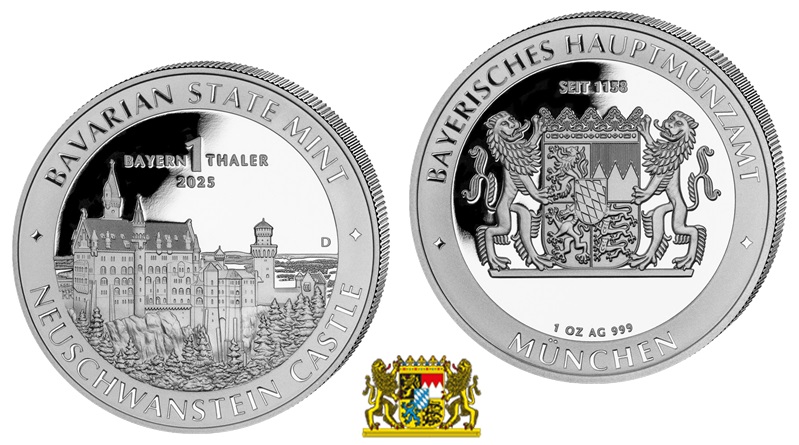
The obverse side depicts the Neuschwanstein Castle, built in the 19th century and known for its outstanding architecture which is also a landmark in the Free State of Bavaria. The Castle is centred with the denomination BAYERN 1 THALER along with the year of minting 2025 which is shown just above the primary design. Below the shield are the specifications of the medal 1 OZ AG 999. Along the upper rim is the recessed text BAVARIAN STATE MINT and along the lower rim is the additional text NEUSCHWANSTEIN CASTLE. The reverse side features the crest of the Bavarian State Mint which includes the year of establishment, 1158 positioned just above the crowned shield. The recessed text above the primary design reads BAYERISCHES HAUPTMÜNZAMT and below, the name of Bavaria’s capital city MÜNCHEN.
| Denomination | Metal | Weight | Diameter | Quality | Mintage Limit |
| Thaler | 999.9 Silver | 31.1 g. | 37 mm. | BU | n/a |
| Thaler | 999.9 Silver | 31.1 g. | 37 mm. | Proof | n/a |
| Thaler | 999.9 Silver | 31.1 g. | 37 mm. | Proof | *1158 |
Available from the 2nd April, both the BU and proof coins are available encapsulated and with or without a presentation case. *A limited edition of 1158 proof pieces are accompanied with a certificate of authenticity. For additional information, please visit the e-webshop of the Bavarian State Mint.
The Bavarian State Mint advises that sales of the Bayern Thaler Neuschwanstein investment medals in gold ranging in sizes from 1/10 ounce to 1 kilogram and silver 1 Kilogram are expected to start in the third quarter of 2025.

Download the Greysheet app for access to pricing, news, events and your subscriptions.
Subscribe Now.
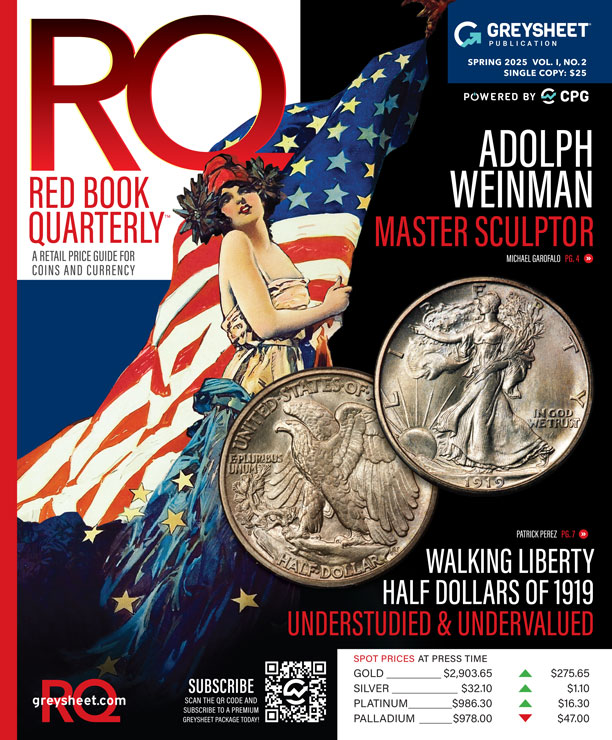
Subscribe to RQ Red Book Quarterly for the industry's most respected pricing and to read more articles just like this.
Author: Michael Alexander
Related Stories (powered by Greysheet News)
View all news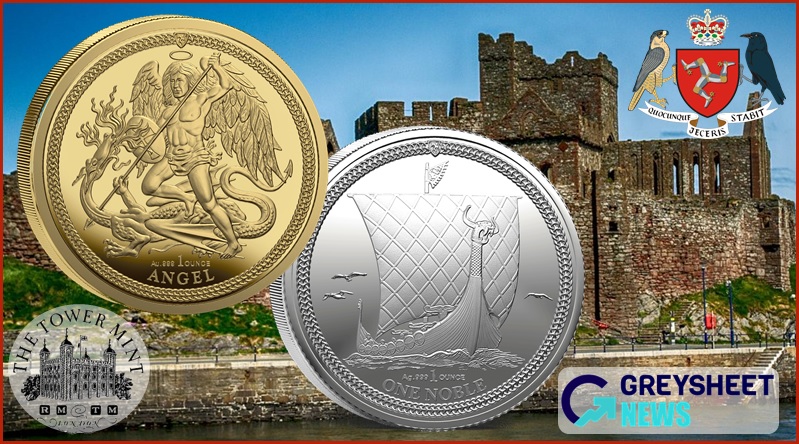
The Government & Treasury of the Isle of Man unveil their annual range of gold and silver collector coins.

The Royal Canadian Mint release new silver proof coins honouring the Calling of an Engineer ceremony.
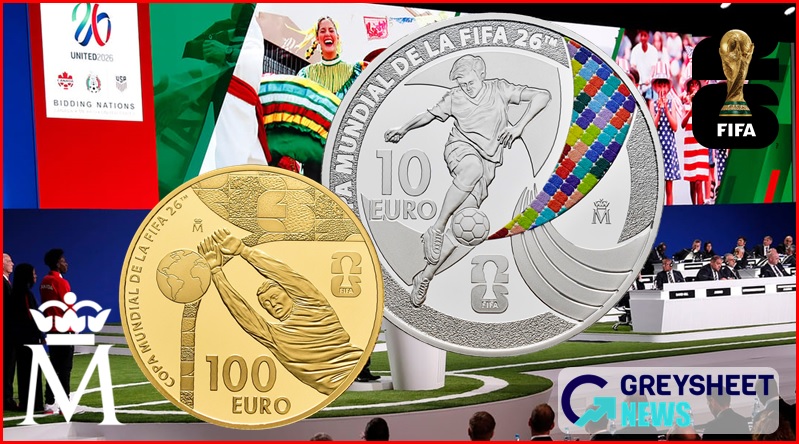
Spain's Real Casa de la Moneda release gold and silver coins in support of Spain's national Football team.


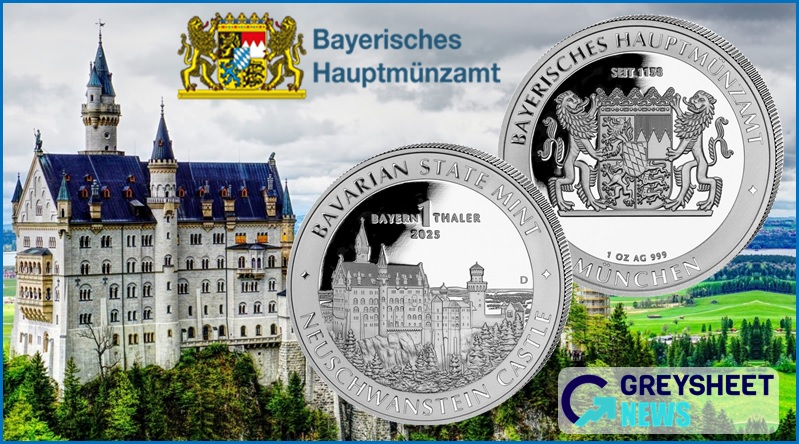






Please sign in or register to leave a comment.
Your identity will be restricted to first name/last initial, or a user ID you create.
Comment
Comments